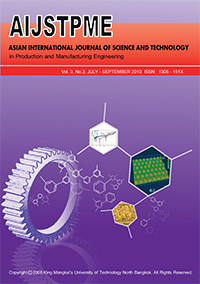Optimization of Joint Strength in Gas Metal Arc Welding by Response Surfaces Methodology
Main Article Content
Abstract
The present study is aimed at investigating the effect of six process parameters on ultimate tensile strength (UTS) of mild steel parts welded by a Gas Metal Arc Welding (GMAW) process. A Box-Behnken design was used to determine the optimum operating conditions for the GMAW process. The six welding parameters are: wire feed rate, welding voltage, welding speed, travel angle, tip-to-work distance and shielded gas flow rate. A WIN welding machine (model: Migweld350SEF) and an electrode ER70S-6 with rod size diameter of 0.8 mm were used in the experimentation. The welding specimens were randomly prepared and tested. The result at the significance level of 0.05 indicated that the optimal conditions for welding were 19 m/min of wire feed rate, 30 volts of welding voltage, 8 in/min of welding speed, 60 degree of welding angle, 7mm of tip-to-work distance, and 10 l/min of shielded gas flow rate
Article Details
How to Cite
Ampaiboon, A., & Lasunon, O. (2013). Optimization of Joint Strength in Gas Metal Arc Welding by Response Surfaces Methodology. Applied Science and Engineering Progress, 3(3), 73–77. retrieved from https://ph02.tci-thaijo.org/index.php/ijast/article/view/67403
Issue
Section
Technology


